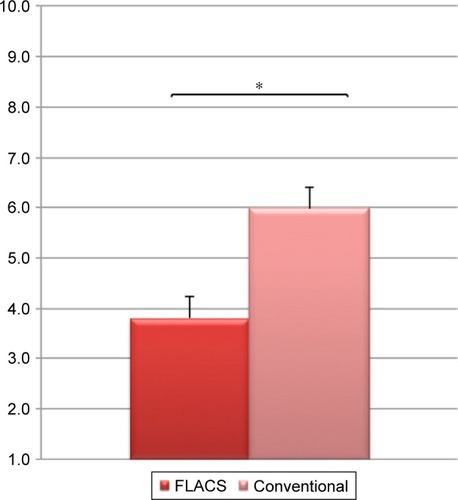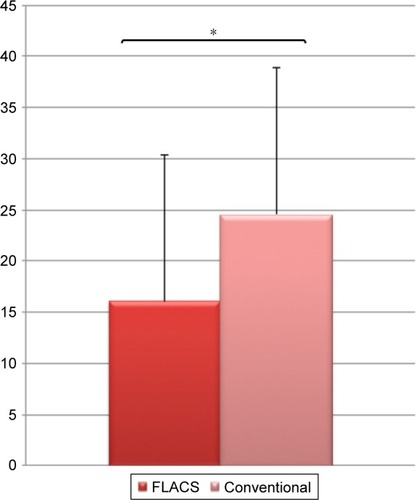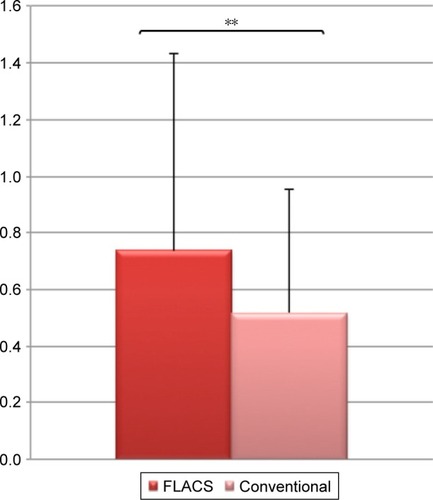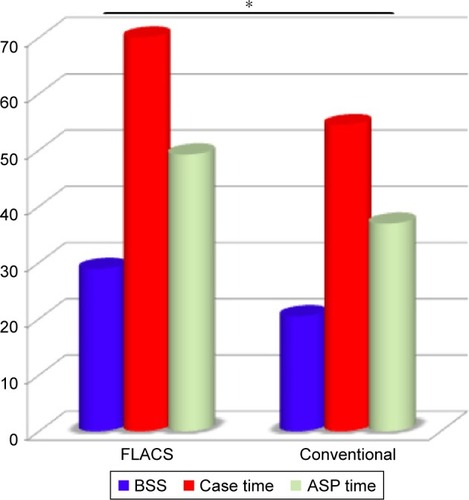Abstract
Purpose
The purpose of this study was to compare intraoperative parameters between femtosecond laser-assisted cataract surgery (FLACS) and conventional phacoemulsification using Centurion® Vision System with Active Fluidics.
Setting
This study was performed at Brasília Ophthalmologic Hospital, Brasília, Federal District, Brazil.
Patients and methods
This was a prospective randomized comparative study. Patients with the diagnosis of cataract and surgical extraction programmed were divided into two groups: conventional phacoemulsification and FLACS. Intraoperative data were collected and submitted for statistical analysis.
Results
A total of 400 eyes were enrolled, 200 in each group. There were no surgical complications. Groups were statistically equivalent in age and nucleus density. Cumulative dissipated energy and torsional time were significantly reduced in the FLACS group. Conventional surgery had less fluid usage, total case time and aspiration (ASP) time.
Conclusion
FLACS with Active Fluidics System can reduce the ultrasound energy use during cataract surgery, in spite of increasing case time, fluid usage and ASP time.
Keywords:
Introduction
Cataract surgery is the most common surgical procedure performed worldwide. Its frequency has greatly increased in the past few decades due to aging of the population and augmented visual needs along with technology development.Citation1
Phacoemulsification made possible for the surgeon to achieve superior and predictable visual outcomes. It consists of an oscillating tip to emulsify the lens associated with an irrigation and aspiration (ASP) device. As incisions developed much smaller and faster healing and foldable intraocular lenses became available, it turned into the preferred technique for cataract removal worldwide. Generation after generation, phacoemulsification machines provided better surgical performance and improved safety. Intraocular use of ultrasound is a major concern for surgeons, since if used recklessly may damage near structures, including corneal endothelium.Citation2,Citation3
Recently, the Centurion® Vision System (Alcon Laboratories, Inc., Fort Worth, TX, USA) introduced Active Fluidics™ platform, which has shown better stability of anterior chamber, decreasing the postocclusion surge even at high ASP and vacuum settings with lower intraocular pressure during the procedure, compared with other platforms.Citation4,Citation5
Femtosecond laser-assisted cataract surgery (FLACS) is the latest major change in surgical technique since the introduction of phacoemulsification. It has been increasingly adopted in cataract surgery centers. This technology consists of a photodissection laser to create corneal incisions, anterior capsulotomy and fragmentation of the nucleus, which are key steps of the cataract surgery. The remaining steps (ASP of the lens cortical material and implantation of the lens) of the surgery still need an assessment of surgeons’ ability to complete the surgery. According to the recently published evidence, the laser is more accurate in executing the capsulorrhexis (shape and size), achieving better centration of the intraocular lens and fewer tilt and intraocular high-order aberrations.Citation6–Citation9 The previous fragmentation of the nucleus also allows for less use of ultrasound energy, reducing risk of structural damage.Citation7,Citation8,Citation10–Citation13
Since the new technique is of substantial cost, many papers have addressed to compare conventional surgery versus FLACS; however, there is still lack of evidence to describe whether the new technique actually brings effective phacoemulsification time.Citation21 In addition, there is great bias involving surgeons still in learning curve of the technique and studies comprising different surgeons and phaco machines.Citation7,Citation9–Citation13
This study aimed to compare clinical and intraoperative parameters between FLACS versus conventional phacoemulsification using Centurion Vision System with Active Fluidics.
Patients and methods
This was a prospective randomized comparative study performed at Brasília Ophthalmologic Hospital between August 2015 and January 2016. The study was approved by the institutional review board of University of São Paulo, Brazil. Enrolled patients were randomized into two groups: conventional phacoemulsification and FLACS. Preoperative evaluation consisted of biomicroscopy with cataract nucleus density classification in an unmasked manner by comparison with Lens Opacity Classification System (LOCS) III and the Pentacam® Nucleus Staging (PNS) software (Oculus Optikgerate GmbH, Wetzlar, Germany). All surgeries were performed by the same surgeon (WTH) using the Centurion Vision System with Active Fluidics with the 0.9 mm 45° ASP bypass system Intrepid Balanced Tip (Alcon Laboratories, Inc.), the 0.9 mm Intrepid Ultra Infusion Sleeve and OZil® Handpiece (Alcon Laboratories, Inc.), with the same ultrasound and fluidics configuration: continuous linear torsional, minimum =10% and maximum =100%; longitudinal power =0; vacuum linear, minimum =70 mmHg and maximum =350 mmHg; irrigation IOP =60 mmHg; ASP rate =35 cc/min; dynamic rise =0 and OZil IP settings of 95% vacuum threshold, torsional-longitudinal ratio of 1.0 and longitudinal pulse of 20 ms. The OZil Intelligent Phaco IP software (Alcon Laboratories, Inc, Fort Worth, TX, USA) is a dynamically adaptive intelligent energy management system that continuously monitors and responds with a longitudinal ultrasound (Intelligent Phaco IP) to ongoing phacoemulsification conditions throughout the procedure, reduces occlusion and keeps the lens material flow to and through the tip. In our study, parameter longitudinal time is exceptionally for Intelligent Phaco IP.
All FLACSs were performed with LenSx® (Alcon Laboratories, Inc.) using the same parameters for nucleus treatment: one 6.0 mm diameter cylinder with fragment pattern, 12 µJ of laser energy, spot and layer separation of 20 µm and fragment size of 400 µm. Clear corneal main incision was performed in the steepest axis of the cornea, and arcuate limbal relaxing incisions were realized following standard protocol.Citation22 Laser capsulotomy had a 4.9 mm diameter. The karate prechop technique was used for all manual cases.
All eligible patients provided written informed consent, aged between 59 and 80 years, and had a diagnosis of cataract and planned phacoemulsification for one or both eyes. The key exclusion criteria included presence of white cataracts, need for mechanical dilation of pupil, weak or broken zonular fibers, known zonular instability or zonular dehiscence.
The main outcome measures were cumulative dissipated energy (CDE), torsional time (s), longitudinal time (s) (Intelligent Phaco IP), case time (s), fluid usage (s) and ASP time (s), as provided by the display on the user interface at the end of phacoemulsification. Measures were taken from the beginning of the surgery until the end of complete nucleus removal. Preoperative and postoperative (at 1 month) endothelial cell counts were measured using Nidek® CEM-530.Citation11 The CDE is a built-in device of the Alcon Laboratories, Inc. It is an estimation of the ultrasound energy expended during the lens removal in a phacoemulsification cataract surgery. CDE information was determined using the formula: US power average × US time + torsional amplitude average × torsional US time ×0.4 measured in percent-seconds (%-s).
Collected data were submitted for statistical analysis using SPSS for Windows. Demographics data, safety outcomes and preoperative characteristics were summarized descriptively. Key outcomes were compared using covariance analysis with a significance level (P) of 0.05.
Results
Cataract surgery removal was performed in 400 eyes, 200 in each group (conventional surgery vs FLACS). There were no intraoperative complications.
There were no significant differences in age and cataract density classification between the groups ().
Table 1 Age, LOCS III and PNS between FLACS and conventional surgery using Centurion Vision System with Active Fluidics Phaco Platform
FLACS group showed significantly less CDE and torsional time ( and ).
Figure 1 Comparison of CDE between FLACS and conventional surgery using Centurion Vision System with Active Fluidics Phaco Platform.
Abbreviations: CDE, cumulative dissipated energy; FLACS, femtosecond laser-assisted cataract surgery.

Figure 2 Comparison of torsional time (s) between FLACS and conventional surgery using Centurion Vision System with Active Fluidics Phaco Platform.
Abbreviation: FLACS, femtosecond laser-assisted cataract surgery.

Use of balanced salt solution (BSS), total case time, ASP time and longitudinal time (Intelligent Phaco IP) were significantly lower on the conventional group ( and ).
Figure 3 Comparison of phacoemulsification time (s) between FLACS and conventional surgery using Centurion Vision System with Active Fluidics Phaco Platform.
Abbreviation: FLACS, femtosecond laser-assisted cataract surgery.

Figure 4 Comparison of fluid usage (BSS), case time (s) and ASP time (s) between FLACS and conventional surgery using Centurion Vision System with Active Fluidics Phaco Platform.
Abbreviations: BSS, balanced salt solution; ASP, aspiration; FLACS, femtosecond laser-assisted cataract surgery.

Endothelial cell loss was not significantly different between groups.
Discussion
Presently, few published literatures comparing FLACS versus manual phacoemulsification regarding surgical outcomes exists. Many of the studies found in the literature were performed gathering data from different surgeons with no reference for surgical parameters or phacoemulsification machines, which are important factors for bias.Citation14,Citation20,Citation23–Citation25
To our knowledge, this is the first study that compared FLACS versus conventional phacoemulsification with a single surgeon and used exclusively the Centurion Active Fluidics System.
In recent years, FLACS has become more popular among ophthalmologists. The femtosecond laser has been introduced into phacoemulsification cataract surgery to effectively perform a bladeless arcuate and corneal incisions, capsulotomy and nuclear fragmentation. Numerous clinical studies have reported advantages of FLACS as reduced ultrasound energy, corneal endothelial cell damage and cornea edema.Citation14–Citation18
The importance of the single surgeon case series comes from the existing learning curve for FLACS, as demonstrated in the literature.Citation24 In our study, the surgeon had performed ~2,500 FLACS cases prior to the study; therefore, there are no learning curve implications.
Our data showed that FLACS can reduce CDE and torsional time in comparison to conventional surgery, which agrees with a recent publication.Citation25 Data have shown that conventional surgery used almost twice CDE time and at least 50% more of torsional time than FLACS. The importance of less ultrasound energy use during the procedure is well established in the literature, reducing corneal edema and endothelial cell loss.Citation26,Citation27
The role of FLACS with respect to endothelial cell loss reduction is not yet fully comprehended. Abell et al showed that endothelial cell loss is lower in FLACS at 3 weeks postoperatively, but with no differences at 6 months. FLACS with zero effective phaco time and manually created corneal incisions had statistically significantly less endothelial cell loss at 6 months than FLACS in laser-automated corneal incisions group and conventional phacoemulsification group.Citation19,Citation23 In our study, there was no statistically significant difference in the endothelial cell count between groups at 1 month and 3 months postoperatively, according to the previously mentioned studies.Citation19,Citation23
There was an increased use of longitudinal power (Intelligent Pulse IP) in the FLACS group. Although statistically significant, we believe that this difference is of no relevance for surgical outcomes since the mean IP time in both groups was less than 1 s, while torsional time was responsible for 15 s in the FLACS group and 20 s in the conventional group with no difference in the endothelial cells.
Several studiesCitation19,Citation20,Citation23,Citation25 recently described the customization of laser fragmentation patterns to the type and density of the cataract. We standardized lens-softening pattern to improve academic value to the study. The femtosecond laser has a variety of methods with laser fragmentation patterns for lens-softening process, indicating that less effective phacoemulsification time is needed to emulsify the lens, but shows a distinct result concerned to case time and BSS usage.Citation25,Citation28 Fluid volume (BSS), case time and ASP time were significantly higher in the FLACS group. This finding confronts published literature, where these parameters were not of statistical significance between groups.Citation11
In summary, this study found that the use of new technologies modifies surgical efficiency in different degrees. Manual phacoemulsification performed by an experienced surgeon with good technology and appropriate fluidic settings provides similar surgical outcomes. Research into new technologies should benefit in improving the efficiency of various surgical approaches. Further studies should evaluate other phacoemulsification machines and laser parameters.
What was known:
FLACS is able to reduce ultrasound energy use in cataract surgery.
What this paper adds:
With the Active Fluidics System, fluid usage, case time and total ASP time can be higher in FLACS than in manual phacoemulsification.
Disclosure
None of the authors has a financial or proprietary interest in any material or method mentioned. The authors have no affiliations with or involvement in any organization or entity with any financial interest or nonfinancial interest in the subject matter or materials discussed in this manuscript. The authors report no other conflicts of interest in this work.
References
- FosterAVision 2020: Thecataract challengeCommunity Eye Health20001334171917491949
- HanYKMillerKMHeat production: longitudinal versus torsional phacoemulsificationJ Cataract Refract Surg200935101799180519781477
- ChristakisPGBraga-MeleRMIntraoperative performance and postoperative outcome comparison of longitudinal, torsional, and transversal phacoemulsification machinesJ Cataract Refract Surg201238223424122153315
- Sharif-KashaniPFanneyDInjevVComparison of occlusion break responses and vacuum rise times of phacoemulsification systemsBMC Ophthalmol2014149625074069
- SolomonKDLorenteRFanneyDCionniRJClinical study using a new phacoemulsification system with surgical intraocular pressure controlJ Cataract Refract Surg201642454254927113876
- NagyZZKránitzKTakacsAIMiháltzKKovácsIKnorzMCComparison of intraocular lens decentration parameters after femtosecond and manual capsulotomiesJ Refract Surg201127856456921688765
- OshikaTKawanaKHiraokaTKajiYKiuchiTOcular higher-order wavefront aberration caused by major tilting of intraocular lensAm J Ophthalmol2005140474474616226535
- SandersDRSarverEJCookeDLAccuracy and precision of a new system for measuring toric intraocular lens axis rotationJ Cataract Refract Surg20133981190119523889866
- AleJBIntraocular lens tilt and decentration: a concern for contemporary IOL designsNepal J Ophthalmol201131687721505548
- SandersDRHigginbothamRWOpatowskyIEConfinoJHyperopic shift in refraction associated with implantation of the single-piece Collamer intraocular lensJ Cataract Refract Surg200632122110211217137992
- WallaceRB3rdCapsulotomy diameter markJ Cataract Refract Surg200329101866186814604703
- NorrbySSources of error in intraocular lens power calculationJ Cataract Refract Surg200834336837618299059
- KanellopoulosAJAsimellisGStandard manual capsulorhexis/ultrasound phacoemulsification compared to femtosecond laser-assisted capsulorhexis and lens fragmentation in clear cornea small incision cataract surgeryEye Vis (Lond)201632027478858
- AbouzeidHFerriniWFemtosecond-laser assisted cataract surgery: a reviewActa Ophthalmol201492759760324835818
- RobertsTVLawlessMChanCCFemtosecond laser cataract surgery: technology and clinical practiceClin Experiment Ophthalmol201341218018622788831
- SerraoSLombardoGDucoliPRosatiMLombardoMEvaluation of femtosecond laser clear corneal incision: an experimental studyJ Refract Surg201329641842423642006
- DayACGartryDSMaurinoVAllanBDStevensJDEfficacy of anterior capsulotomy creation in femtosecond laser-assisted cataract surgeryJ Cataract Refract Surg201440122031203425305149
- SuttonGBaliSJHodgeCFemtosecond cataract surgery: transitioning to laser cataractCurr Opin Ophthalmol20132413823197263
- AbellRGKerrNMVoteBJToward zero effective phacoemulsification time using femtosecond laser pretreatmentOphthalmology2013120594294823465860
- MastropasquaLMatteiPATotoLAll laser cataract surgery compared to femtosecond laser phacoemulsification surgery: corneal traumaInt Ophthalmol201637347548227377068
- BartlettJDMillerKMThe economics of femtosecond laser-assisted cataract surgeryCurr Opin Ophthalmol2016271768126632918
- NichaminLDNomogram for limbal relaxing incisionsJ Cataract Refract Surg20063291408 author reply 1408
- AbellRGKerrNMHowieARMustaffa KamalMAAAllenPLVoteBJEffect of femtosecond laser-assisted cataract surgery on the corneal endotheliumJ Cataract Refract Surg201440111777178325217072
- BaliSJHodgeCLawlessMRobertsTVSuttonGEarly experience with the femtosecond laser for cataract surgeryOphthalmology2012119589189922361311
- Conrad-HengererIHengererFHSchultzTDickHBEffect of femtosecond laser fragmentation of the nucleus with different softening grid sizes on effective phaco time in cataract surgeryJ Cataract Refract Surg201238111888189422980639
- MuranoNIshizakiMSatoSFukudaYTakahashiHCorneal endothelial cell damage by free radicals associated with ultrasound oscillationArch Ophthalmol2008126681682118541846
- ParkJYumHRKimMSHarrisonARKimECComparison of phaco-chop, divide-and-conquer, and stop-and-chop phaco techniques in microincision coaxial cataract surgeryJ Cataract Refract Surg201339101463146923910714
- NagyZZMcAlindenCFemtosecond laser cataract surgeryEye Vis (Lond)201521126605364
